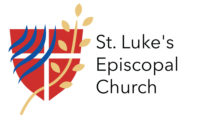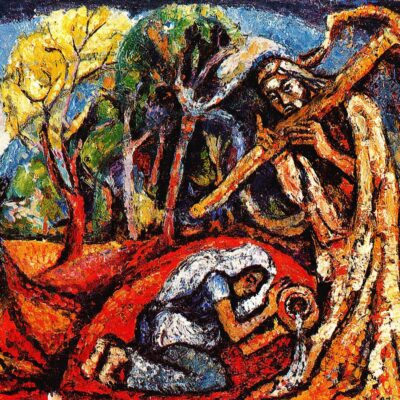Trinity Sunday
The Sunday following Pentecost is Trinity Sunday. It’s a later addition to the church calendar and differs from all the other feasts and festivals. Christmas celebrates the incarnation of Jesus. Easter, his resurrection. Pentecost, the coming of the Holy Spirit. There are feasts marking the extraordinary lives of saints, ancient and modern. But what is the Trinity? Are we celebrating a doctrine? That’s not very exciting, nor is it usual in our Christian history. Or is this about the identity of God, in which case it should be a HUGE celebration, bigger than all the others since it encompasses all aspects of the Holy One.
Maybe, like me, you’ve heard a few sermons either for children or adults, trying to define the concept of the Trinity. My favorite short version is this: God the Father, incomprehensible. God the Son, incomprehensible. God the Holy Spirit, incomprehensible. The whole darn thing, incomprehensible!
And yet, for centuries, we have been trying to explain, defend, convert and teach people about proper belief and doctrine. It occurs to me that one popular model of preaching is the usually male, usually dressed in casual clothes (Dockers and a sport shirt) preacher perched on a stool with a white board or a screen behind him, preaching for 30-40 minutes in a fairly reasonable tone explaining what we’re supposed to know and believe about the Bible, God and how we’re supposed to live. It’s an Enlightenment model of religion, a modernist take on mystery. This preaching more closely resembles a TED talk than an oracle or a revelation. One feels bombarded with words, unable to catch your breath and ask the question, “Is this what I really think, feel and experience?”
So often there is an attempt to reduce faith to rational propositions. We take the poetry of Genesis and try to make it science, calculating the hours and days that it took God to create the universe. We turn our experience of the Holy into a doctrine that requires defending. We create definitions and hold debates for the concepts of breath, birth and beauty without allowing them to live in our hearts, minds and souls. We reduce the relationships of the Trinity, the relationship we have to the Holy One and our own relationships to a formula.
In this model there is no room for poetry, prophecy, song, lament, awe or silence. These are the more classic responses to the presence and power of God. In the face of the Mysterium Tremendum we don’t need an alliterative three-point sermon!
Our Celtic ancestors in the faith lived far away from the centers of power and influence, at the edge and beyond of the Holy Roman Empire. They received the good news of Jesus from poor, wandering monks who traveled by sea, horseback and foot all over Ireland, Scotland and the British Isles. And they created a treasure of simple prayers, holy observances, legends and stories, songs and music that were seldom heard or valued outside of the small towns and rural villages where they lived for centuries.
The Celtic experience of God is deeply Trinitarian, intimately tied to nature and homely, in that it is practiced in the ordinary activities of daily life. Celtic Christianity developed in the liminal spaces, the in between places where transition heightens the senses and deepens the mystery. The Celts live in the borderlands between land water, sea and sky, light and dark, heaven and earth, life and death. Their faith is expressed through imagination in story-telling, symbol, myth and legend.
The great symbolism of the Three permeates Celtic Christianity and the interwoven nature of everything is reflected in art that includes spirals, linked circles and symbols of eternity, all permeated with the colors of nature, deep greens, blues and the red-brown of the earth. If you’ve ever seen color reproductions of the illuminated manuscripts of the Lindisfarne Gospels or the Book of Kells, you will recognize the beauty of nature infused with the light of the divine. They are glorious.
Far from the great Cathedrals and centers of ecclesiastical power, Celts practice an everyday spirituality with prayers for all aspects of life from rising in the morn to laying down at night and everything in between including the lighting of the fire, the drawing of water, rocking the baby, doing the dishes and sweeping the hearth. This is the spirituality of the populace not the priest. It is lay spirituality, rooted in the labor and rest of the common person. It is about living together in harmony, unity, interrelationship and interdependence.
My first experience of Celtic Christianity came during my time in seminary in Oxford, England. All the seminarians were offered a stay at the restored Abbey on the Island of Iona off the NW Coast of Scotland during Spring vacation in March. I suppose it’s because no tourist in their right mind would travel the entire length of the country, over two ferries and a bus ride while it was still cold and dark that far north!
Years earlier, St. Julian of Norwich from her enclosed anchorite attached to the local church wrote this:
“Suddenly, the Trinity filled my heart most of joy. And so I understood it shall be in heaven without end, to all that shall come there. For the Trinity is God, God is the Trinity. The Trinity is our maker, the Trinity is our keeper, the Trinity is our everlasting lover, the Trinity is our endless joy and our bliss, for where Jesus appears, the blessed Trinity is understood.”
Perhaps you have had an experience of awe and wonder. You may have felt a connection to the universe, to God, to the community of people all around you. Maybe you’ve been overcome by beauty or moved to tears by music. You’ve sensed your place in the great, turning of the world and caught a glimpse of the vastness of creation. Boundaries collapse and expand. Everything is interconnected. It may have been in the simple gesture of a baby grasping your finger or a hug after a difficult time. In that moment, you know yourself to be surrounded, held in the vast web of relationship that is the Trinity. You know that you are not alone. As Jesus has promised, “Remember, I am with you always, to the end of the age.”
Perhaps you have had an experience of awe and wonder. You may have felt a connection to the universe, to God, to the community of people all around you. Maybe you’ve been overcome by beauty or moved to tears by music. You’ve sensed your place in the great, turning of the world and caught a glimpse of the vastness of creation. Boundaries collapse and expand. Everything is interconnected. It may have been in the simple gesture of a baby grasping your finger or a hug after a difficult time. In that moment, you know yourself to be surrounded, held in the vast web of relationship that is the Trinity. You know that you are not alone. As Jesus has promised, “Remember, I am with you always, to the end of the age.”
As the great Celtic Saint, Patrick prayed:
Christ be with me, Christ within me,
Christ behind me, Christ before me,
Christ beside me, Christ to win me,
Christ to comfort and restore me.
Christ beneath me, Christ above me,
Christ in quiet, Christ in danger,
Christ in hearts of all that love me, Christ in mouth of friend and stranger.
And as we go forth into our daily lives and this dangerous world, we pray:
I bind unto myself the Name,
the strong Name of the Trinity,
by invocation of the same,
the Three in One and One in Three.
By Whom all nature hath creation,
eternal Father, Spirit, Word:
praise to the Lord of my salvation,
salvation is of Christ the Lord.
Amen.




Gerry Talsky
Thanks to Canon Britt,
Belatedly I am thanking Britt for delivering my discarded wallet to me several months ago. I was so glad to get my identification back. I want to make a small donation to the church. I’m impressed by the array of good works that are performed.